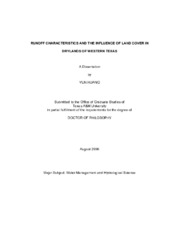| dc.contributor.advisor | Munster, Clyde L. | |
| dc.contributor.advisor | Wilcox, Bradford P. | |
| dc.creator | Huang, Yun | |
| dc.date.accessioned | 2010-01-15T00:16:04Z | |
| dc.date.accessioned | 2010-01-16T02:18:30Z | |
| dc.date.available | 2010-01-15T00:16:04Z | |
| dc.date.available | 2010-01-16T02:18:30Z | |
| dc.date.created | 2006-08 | |
| dc.date.issued | 2009-06-02 | |
| dc.identifier.uri | https://hdl.handle.net/1969.1/ETD-TAMU-1879 | |
| dc.description.abstract | In dryland regions, where water is a limited resource, land use/land cover
has undergone and continues to undergo significant change mainly due to
human activities. The nature of runoff from dryland regions and the influence of
land use/land cover change are largely not quantified. The objective of this study
is to examine runoff dynamics and the influence of land cover in drylands of
western Texas across multiple spatial and temporal scales. The study consists
of four major components: (1) an experimental study at Honey Creek upland
catchment (19 ha) to assess vegetation treatment effects on runoff by
hydrometric and isotopic methods; (2) a hydrochemical evaluation of hydrologic
linkage between the upland and bottomland at the second-order Honey Creek
watershed; (3) a detailed precipitation-streamflow analysis at North Concho
River basin to assess long-term and large-scale precipitation-streamflowvegetation
dynamics; and (4) a comparison of streamflow in North, Middle, and
South Concho River basins and a regional streamflow trend analysis for the
entire western Texas. The study indicates runoff production in the drylands of western Texas is dominated by a few large runoff-producing events. The small
catchment experiment indicated that runoff increased about 40 mm per year
when 60% of woody plants were removed. This effect may relate to the
presence of a baseflow component, but was not verified in regional trend
analysis for the Edwards Plateau region where most rivers are spring-fed. The
decrease in streamflow in North Concho River basin after the 1950's is in large
part related to the enhanced infiltration capacity from reduced grazing pressure
and improved vegetation cover. Regional streamflow trend analysis suggests
some headwater areas outside the Edwards Plateau region experienced
patterns of streamflow change similar to those in North Concho River basin,
although artificial impoundments complicated the analysis. The study has
broader application in ecohydrological research beyond specific geographic
areas and specific vegetation types when evaluating the impact of ecosystem
structure change on hydrology and water resources. | en |
| dc.format.medium | electronic | en |
| dc.format.mimetype | application/pdf | |
| dc.language.iso | en_US | |
| dc.subject | runoff | en |
| dc.subject | streamflow | en |
| dc.subject | land cover | en |
| dc.subject | land use | en |
| dc.subject | ecohydrology | en |
| dc.subject | precipitation | en |
| dc.subject | Edwards Plateau | en |
| dc.subject | Texas | en |
| dc.title | Runoff characteristics and the influence of land cover in drylands of western Texas | en |
| dc.type | Book | en |
| dc.type | Thesis | en |
| thesis.degree.department | Council of Deans | en |
| thesis.degree.discipline | Water Management and Hydrological Sciences | en |
| thesis.degree.grantor | Texas A&M University | en |
| thesis.degree.name | Doctor of Philosophy | en |
| thesis.degree.level | Doctoral | en |
| dc.contributor.committeeMember | Boutton, Thomas, W. | |
| dc.contributor.committeeMember | Mohanty, Binayak P | |
| dc.type.genre | Electronic Dissertation | en |
| dc.type.material | text | en |
| dc.format.digitalOrigin | born digital | en |


